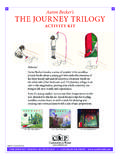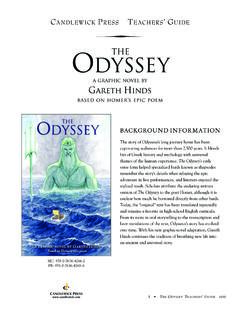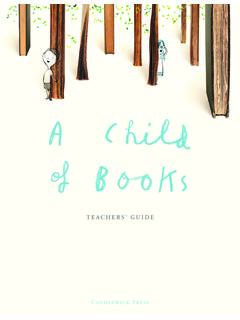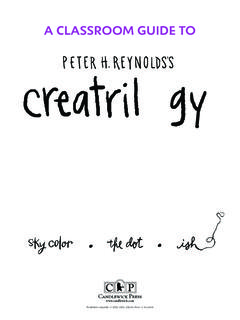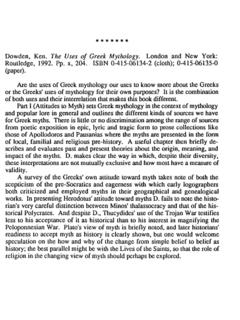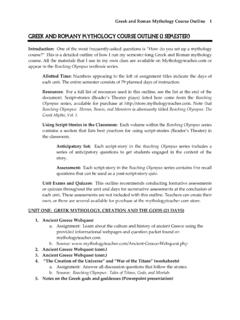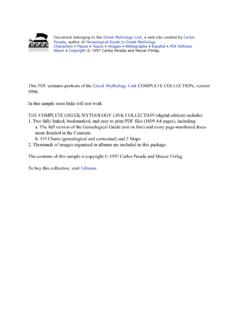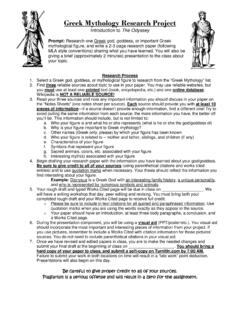Transcription of Teachers’ Guide - Candlewick Press
1 Teachers GuideMythology: The Gods, Heroes, and Monsters of Ancient Greeceby Lady Hestia Evans edited by Dugald A. Steer illustrated by Nick Harris, Nicki Palin, and David Wyatt decorative friezes by Helen WardAge 8 and up Grade 3 and upISBN: 978-0-7636-3403-2$ ($ CAN) Candlewick Press mythology Teachers Guide 1A B OU T T H E B O OK mythology purports to be an early nineteenth-century primer on greek myths written by Lady Hestia Evans. This particular edition is inscribed to Lady Hestia s friend John Oro, who was embarking on a tour of the sites of ancient Greece.
2 Along his journey, Oro has added his own notes, comments, and drawings in the margins including mention of his growing obsession with the story of King Midas and a visit to Olympus to make a daring request of Zeus himself..This Guide to mythology is designed to support a creative curriculum and provide opportunities to make links across subjects. The suggested activities help students make connections with and build on their existing knowledge, which may draw from film, computer games, and other popular media as well as books and more traditional sources.
3 We hope that the menu of possibilities presented here will serve as a creative springboard and inspiration for you in your classroom. For your ease of use, the Guide is structured to follow the book in a chapter-by-chapter order. However, many of the activities allow teachers to draw on material from several chapters. For instance, the storytelling performance activity outlined in the section An Introduction to mythology could also be used with stories from other chapters. Likewise, many of the activities focused on The Odyssey would apply equally well to the chapter on the Trojan War.
4 Candlewick Press mythology Teachers Guide 2 Discussion Points1. Do students know the word mythology ? In what context have they heard it? Encourage them to draw as widely as possible on their own cultural references. Students may, for instance, be familiar with stories, books, films, comic strips, or the computer game Age of mythology . Invite them to share the myths they know with a partner or in a small After discussing students prior knowledge of the subject, ask them to propose a definition for mythology .
5 Encourage them to use a range of dictionaries to check their suggestions. Write the dictionary definition on a large sheet of paper and display it in the Explain that different cultures give rise to their own mythologies and that there are many similarities among them, such as creation stories and hero tales. Note that there are also clear differences among cultural mythologies. Ask students to point out clues from the cover of mythology that suggest which culture it draws Talk about the image in the center of the cover.
6 What does it suggest? Some possibilities for discussion include heroes, monsters, action, and the forces of good and Discuss the word ancient. Have students provide a dictionary definition. Make a timeline and place the ancient greek Empire on it. (Note that there are differences of opinion but that historians generally use the dates between 1000 BCE and the death of Alexander the Great, in 323 BCE. Make sure students understand the use of the terms BCE and CE.)Activ itiesOn Displ ayInvolve the class in making a display or class museum.
7 It might include such elements as:books about ancient Greece and greek mythologypostcards, photographs, and travel posters showing greek monumentstravel souvenirs such as postcards, photos, and other materials collected by students who have visited Greece, who may wish to add informative labels maps and a globedictionaries for identifying word originsTr a nsfOr m yOur Cl a ssrOOmConsider transforming the entire classroom into a greek temple. Run a frieze along the top of the wall, perhaps depicting the twelve labors of Heracles or the voyage of the Argo (see the page borders in mythology ).
8 Invite students to help create greek columns from paper and use them to designate display areas. B E F OR E R E A DI NGCandlewick Press mythology Teachers Guide 3 Discussion Points1. Encourage students to consider the story that is being set up. What image do they have of Lady Hestia Evans? What image do they have of John Oro?2. What do the students think has happened to John Oro when he writes, I feel I can no longer hold this pen ? Encourage them to predict how the story will Work with students to create character profiles based on the information presented in this first spread and the inferences they can itiesHOw a-muse-ing!
9 Have students read Lady Hestia Evans s poem O Muses. Then have them research the greek Muses and create a chart listing the Muses and their areas of influence. They might illustrate the chart with these or other works of art, located via the Internet or other sources:Birth of the Muses, by Jean-Dominique Ingres (Louvre)Minerva Visiting the Muses, by Jacques de Stella (Louvre)The Reign of the Muses, by Lorenzo Costa (Louvre)Bon VoyageHave students imagine that they are preparing for a tour to Greece. Lead a role-play in which you take the part of tour leader and students respond as if they are fellow travelers.
10 Ask students to reflect on their expectations for the voyage: What preparations would they make? How would they feel about leaving family behind? What means would they use to get there?De a r Di a ryFollowing the role-play above, invite students to write from the point of view of their character. For instance, they might write a diary entry in the voice of a traveler who is leaving for Greece the next day. T I T L E PAGE S PR E A DCandlewick Press mythology Teachers Guide 4 Activ itiesiT s gr eek TO usThe booklet titled The Basics of Ancient greek may serve as a basis for the following activities: Ask students to decipher the names of the gods printed in the gold borders on the cover of students write their own names in greek characters.
